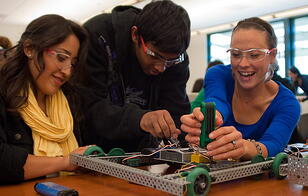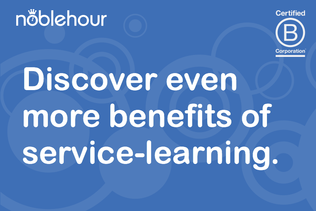"Empowering NobleLeaders": How Service & Service-Learning Spark Social Justice
As mentioned in our last “Empowering NobleLeaders” post where we highlighted this year’s 25th annual National Service Learning Conference as well as the Global Youth Service Day, the numbers of students, faculty, administrators, and community organizers who take volunteerism to the next level with service learning and active civic engagement are incredible, increasing, and very much needed in our society today. Not only are the opportunities to serve one’s community plentiful and diverse, so are the issues surrounding poverty, race or ethnicity, religion, sexual orientation, physical ability, civil rights and immigration status in  our local and global communities[i]. In our society, where it seems resources are increasingly scarce, the need for students to learn about and take action towards social and environmental problems is critical for the future of a just & peaceful society, and it contributes towards the ability for any person from any background to realize their potential in the society where they live and work.
our local and global communities[i]. In our society, where it seems resources are increasingly scarce, the need for students to learn about and take action towards social and environmental problems is critical for the future of a just & peaceful society, and it contributes towards the ability for any person from any background to realize their potential in the society where they live and work.
More and more, teachers of a variety of grade levels, including K-12 and higher education, are employing service learning curriculum to guide students in addressing and reflecting on complex social issues while learning about course material and earning grades. Service learning cultivates social awareness, community engagement, problem-solving skills, and initiative for both learning and taking action. Service learning can provide the ultimate experiential education--- motivating students to explore the complexity of intertwined community needs, use their knowledge to do something about them, and continue to work for change even after a final grade is made. According to Cathryn Berger Kaye and Maureen Connolly, two innovative leaders in curriculum for service learning, in their article Social Justice and Service Learning,
“The issues we face as a planet have risen to a level that calls us all into action. We can all be engaged in learning about and addressing critical interrelated issues-- hunger, potable water, climate change, population migration, loss of habitat, illiteracy, gun violence, war-- while contributing to the betterment of ourselves and others.”[ii]
Service learning creates meaningful connections between people, helping us to feel invested in our community and emphatic for less fortunate people all over world. Through helping others, students gain valuable social and self awareness. When service is part of academic curriculum, there is great potential for significant civic engagement, enhanced active learning, and using classroom knowledge for a public purpose or community impact. Berger Kaye has found that service learning, when effectively engaged, leads to the development of students into change agents who are aware and passionate about lessening the inequities and injustices created by social structures in their communities[iii] – the foundation for the ability of service to spark social justice.
Students of all ages often complain that the material they learn in certain classes is not useful and thus focus only on short term memorization for the final exam.
 Service learning curriculum directly combats this occurrence through an initial survey of student interests, skills, and talents in addition to a social analysis of the community issues and needs being studied in relation to course material. If students feel connected to or personalize a community issue, they are more motivated to learn about and improve the situation. It is important for service learning educators to always consider the community needs first to create the most useful solutions as well as to emphasize for their students the importance of collective social justice and well-being.
Service learning curriculum directly combats this occurrence through an initial survey of student interests, skills, and talents in addition to a social analysis of the community issues and needs being studied in relation to course material. If students feel connected to or personalize a community issue, they are more motivated to learn about and improve the situation. It is important for service learning educators to always consider the community needs first to create the most useful solutions as well as to emphasize for their students the importance of collective social justice and well-being.
Social justice is both a process and a goal. The process focuses on the understanding and change of social structures that create inequality. The goal is a global community with social responsibility toward and with others, where resources are equitable and all members are physically and psychologically safe and secure.[iv]
Service learning is the key to educating students and preparing them to live purposeful, civically engaged, and socially responsible lives in the 21st century. General guidelines and more detailed service learning resources for both educators and students can be found in Don’t Just Count Your Hours, Make Your Hours Count. Not only is it in the students’ best interest to explore community engagement for both altruistic and practical reasons, today it is an educator's responsibility to provide what is needed for students to recognize, understand, and ultimately address the real life social issues learned in the classroom. The world needs innovative leaders to solve complex national and social issues and students deserve an education that will prepare them for changemaker roles. It is no longer enough to keep students engaged in class-- they must become engaged in their communities in ways that both alleviate suffering or inequality for others as well as bring meaning to the articles, books, and historical accounts read throughout the course. This takes special preparation and commitment, but truly makes the classroom experience more enjoyable for students and teachers alike. Service Learning for Social Change: A Curriculum Development Workbook is a wonderful tool for teachers exploring how to incorporate service learning created by the Service Learning Institute at California State University, Monterey Bay.
As Helen Keller said, “Until the great mass of the people shall be filled with the sense of responsibility for each other’s welfare, social justice can never be attained.” Today this critical pursuit must start with the education and service of students.
[i]
[i] Berger Kaye, Cathryn & Connolly, Maureen. “Social Justice and Service Learning.”CBK Associates, 2013.
[ii][ii] Berger Kaye, Cathryn & Connolly, Maureen. “Social Justice and Service Learning.”CBK Associates, 2013.
[iii][iii] Berger Kaye, Cathryn & Connolly, Maureen. “Social Justice and Service Learning.”CBK Associates, 2013.
[iv][iv]http://studentactivities.tamu.edu/site_files/Definitions%20Related%20to%20Service.pdf. Texas A&M Department of Student Activities, 2009.






